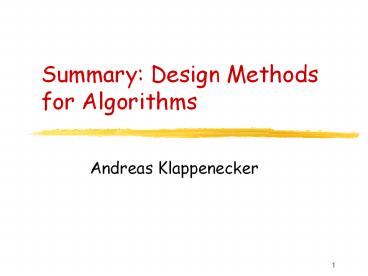Summary: Design Methods for Algorithms PowerPoint PPT Presentation
Title: Summary: Design Methods for Algorithms
1
Summary Design Methods for Algorithms
- Andreas Klappenecker
2
Design Methods
- We have discussed examples of the following
algorithm design principles - Dynamic Programming Paradigm
- Greedy Paradigm
- Divide-and-Conquer Paradigm
3
Main Question
- When can one successfully use one of these
algorithm design paradigms to solve a problem?
4
Dynamic Programming
5
Dynamic Programming
- The development of a dynamic programming
algorithm can be subdivided into the following
steps - Characterize the structure of an optimal solution
- Recursively define the value of an optimal
solution - Compute the value of an optimal solution in a
bottom-up fashion - Construct an optimal solution from computed
information
6
Key Question
- When can we apply the dynamic programming
paradigm?
7
Optimal Substructure
- A problem exhibits optimal substructure if and
only if an optimal solution to the problem
contains within it optimal solutions to
subproblems. - Whenever a problem exhibits optimal substructure,
it is an indication that a dynamic programming or
greedy strategy might apply.
8
Overlapping Subproblems
- A second indication that dynamic programming
might be applicable is that the space of
subproblems must be small, meaning that a
recursive algorithm for the problem solves the
same subproblems over and over. - Typically, the total number of distinct
subproblems is a polynomial in the input size.
9
Overlapping Subproblems
- When a recursive algorithm revisits the same
problem over and over again, then we say that the
optimization problem has overlapping subproblems.
- Here two subproblems are called overlapping if
and only if they really are the same subproblem
that occurs as a subproblem of different
problems.
10
Note
- If a recursive algorithm solving the problem
creates always new subproblems, then this is an
indication that divide-and-conquer methods rather
than dynamic programming might apply.
11
Greedy Algorithms
12
Greedy Algorithms
- The development of a greedy algorithm can be
separated into the following steps - Cast the optimization problem as one in which we
make a choice and are left with one subproblem to
solve. - Prove that there is always an optimal solution to
the original problem that makes the greedy
choice, so that the greedy choice is always safe.
- Demonstrate that, having made the greedy choice,
what remains is a subproblem with the property
that if we combine an optimal solution to the
subproblem with the greedy choice that we have
made, we arrive at an optimal solution to the
original problem.
13
Greedy-Choice Property
- The greedy choice property is that a globally
optimal solution can be arrived at by making a
locally optimal (greedy) choice.
14
Optimal Substructure
- A problem exhibits optimal substructure if and
only if an optimal solution to the problem
contains within it optimal solutions to
subproblems.
15
Divide-and-Conquer
16
Divide-and-Conquer
- A divide and conquer method can be used for
problems that can be solved by recursively
breaking them down into two or more sub-problems
of the same (or related) type, until these become
simple enough to be solved directly. The
solutions to the sub-problems are then combined
to give a solution to the original problem. - This approach is particularly successful when the
number of subproblems remain small in each step
and combining the solutions is easily done.

